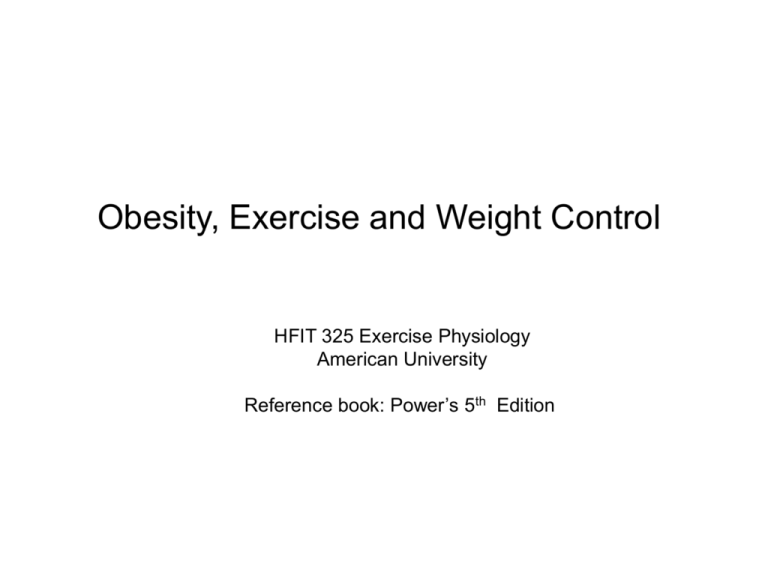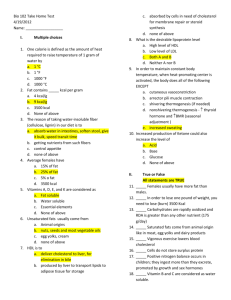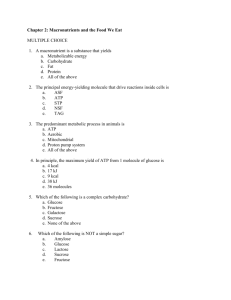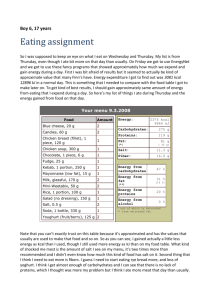What would the corresponding body weight range be?
advertisement

Obesity, Exercise and Weight Control HFIT 325 Exercise Physiology American University Reference book: Power’s 5th Edition Obesity OBESITY IS A MEDICAL TERM MEANING THE STORAGE OF EXCESS FAT IN THE BODY NORMAL RANGE OF FAT % MALE 3% - 20%, OVERFATNESS >20% FEMALE 12% - 30%, OVERFATNESS >30% Use BMI of ≥ 30 as obesity, 15% in 1976-1980 to 23.3% in 1988-1994 to 30.9% in 1999-2000 Review: 1. Fat % 2. Location of fat 3. Fat cell number and fat cell size What is a desirable body weight? It is important to think in terms of a weight range rather than a single value T. 16.3 p446 Fox A reasonable goal would be to achieve ‘optimal fitness’ Example: for man, percent body fat is between 12-18% What would the corresponding body weight range be? 1. Calculate the fat weight: FW = BW X Ff 2. Calculate the fat-free weight: FFW = BW - FW 3. Calculate the desirable target weight: FFW TW = ---------------(1 – Fx) BW (1 – Ff) TW = ---------------------(1 – Fx) FW = fat weight BW = measured body weight Ff = fractional expression of the percent body fat FFW = fat-free weight or lean body weight TW = desired target weight Fx = fractional expression of the target percent body fat Mr. Fittmann: Current weight: 200 lb (90.7 kg), Percent fat: 17%, Height: 70 in (178 cm), Age: 27 Goal: to achieve ‘optimal fitness” for body composition (12-18% body fat) What weight range would we recommend? Step 1. FW = BW X Ff = 200 X 0.27 = 54 lb Step 2. FFW = BW – FW = 200 – 54 = 146 lb Step 3. Target weight at 12% fat: TW = FFW / (1 – Fx) = 146 / (1-0.12) =146 / 0.88 = 166 lb Target weight at 18% fat: TW = FFW / (1 – Fx) = 146 / (1-0.18) =146 / 0.82 = 178 lb Fittmann must lose between 22 – 34lb of his 54 lb of body fat to achieve the Recommended 12% to 18% body fat. Also, it is not necessary that he lose 34 lb of body fat. That is merely the lower end of the recommended range. Energy Balance & Weight Control Too much food Positive energy balance Gain weight Quantity of food for body maintenance & growth Body consumes its own fat, then protein, Loss weight Energy needs exceed that produced from food Negative energy balance Energy Balance & Weight Control Daily caloric need = BEE + GA + Ex BEE = basal Energy Expenditure GA = Energy Cost of General Activities (eating, walking, sitting, reading.. EX = Energy Cost of Exercise Ross & Jackson: equations for estimating basal energy expenditure, In calories, that takes into account age, gender, height, and weight. Basal Energy Expenditure (BEE) For males: BEE = 66 + (13.7 X Wt) + (5 X Ht) – (6.9 X A) For female: BEE = 665 + (9.6 X Wt) + (1.7 X Ht) – (4.7 X A) Wt: kg, Ht: cm, A: years Energy Cost of General Activities (GA) GA = BEE X 20% Energy Cost of Exercise (EX) Energy Cost of Exercise (EX) Fox’s p 450, Table 16.5 Application: Current weight: 200 lb (90.7 kg) Fat % = 27% Height: 70 in (178 cm) Kcal/day= BEE + GA BEE = 66 + (13.7 X 90.7 kg) + (5 X 178 cm) – (6.9 X 27) = 66 + 1243 + 890 – 186 = 2013 kcal GA = BEE X 20% = 2013 X 20% = 403 kcal BEE + GA = 2416 kcal This is what the subject must consume daily to maintain his current weight at 200 lb How to loss 22 lb ???? 3500 kcal/lb X 22lb = 77,000 kcal How long will it take him to achieve this goal? INPUT Reduce total caloric intake 500 kcal 500 kcal X 7 days = 3,500 kcal 3,500 + 2,700 = 6,200 kcal/w 6,200 kcal / 3,500 kcal = 1.75 lb OUTPUT Physical activity For example: jogging 8.5 min/mile, 30 min/day, 5/wks 22 lb Or 34 lb How many weeks? EX = (0.09 kcal/lb/min) X 200 lb X 30 min = 540 kcal/run 540 kcal X 5 session/wk = 2,700 kcal/w 22/1.75 = 12-13 weeks, 34/1.75 = 19-20 weeks






